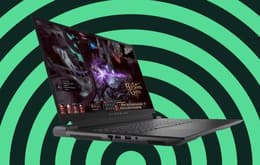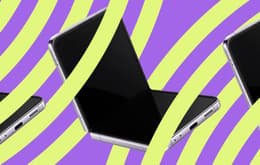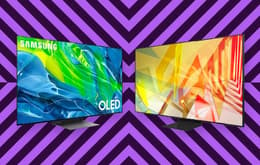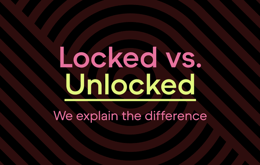
The IBM Simon Personal Communicator (SPC) debuted in 1994, marking the first smartphone and touchscreen phone. Martin Cooper, a Motorola engineer, initiated the first cell phone call in New York City on April 3, 1973. The once-prominent BlackBerry ceased operations in 2022, succumbing to competition from Google and Apple. And by 2023, 97% of Americans possessed a cell phone, with 90% owning a smartphone.
A symphony of beeping, buzzing, and ringing is the soundtrack of our daily lives. But it wasn’t always this way.
The history of cell phones begins with bulky devices and large antennas — a far cry from the sleek, lightweight gadgets the majority of us rely on today. In fact, a 2023 Pew Research study found that 97% of Americans owned a cell phone, and 90% owned a smartphone.
A cell phone is any telephone without a landline connection, whereas a smartphone is more advanced. It offers special features, like internet browsing, mobile apps, or digital assistants like Siri from Apple.
So, how did we go from “the brick” to the first smartphone? From remembering phone numbers by heart to viral memes and hashtags, we’re dialing back the clock into the history of cell phones.
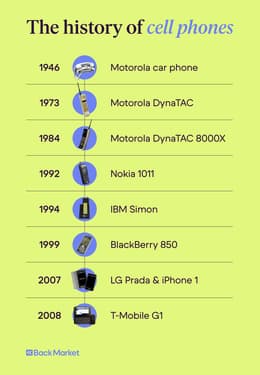
1946: Motorola car phone
Before phones went mobile, communication was primarily anchored to landlines and other wired systems. The notion of taking a phone on the go was a futuristic fantasy.
Portable communication was virtually nonexistent until the 1946 Motorola car phone hit the United States market. The 80-pound device used radio technology to make and receive calls. Its system could only manage a limited number of calls at once, so users could face substantial wait times.
Despite the room for improvement, the ability to take calls from your car was a significant milestone in the history of cell phones.
The Motorola car phone shattered the mold and marked the beginning of mobile communication as we know it today. It showed the world what was possible and opened the door to Motorola’s next breakthrough in portable communications nearly three decades later.
1973: Motorola DynaTAC
Fast forward to April 3, 1973, for another groundbreaking moment in cell phone history — the first call on the Motorola DynaTAC.
Martin Cooper, an engineer at Motorola, stood on the streets of New York City as he made the first call from this cordless phone. To whom? His rival at Bell Laboratories, Joel Engel.
You read that right. The original cell phone call was made by an engineer who wanted to publicly dunk on his competitor. Touché, Mr. Cooper.
Before this historic call, few Americans had access to the car phone. This 1973 prototype marked the beginning of accessible mobile phones. But they still had a long way to go.
The 1973 Motorola DynaTAC weighed around 2.5 pounds, was roughly the size of a brick, and had a battery life of only 20 minutes.
It was another decade before Motorola shocked the world again with the first cell phone to hit a mass market.
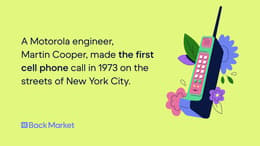
1984: Motorola DynaTAC 8000X
With America’s first cell phone call out of the way, Motorola spent the next decade perfecting the DynaTAC 8000X. It was affectionately nicknamed “the brick” due to its large shape and weight.
The US Federal Communications Commission (FCC) approved this $4,000 mobile device in September 1983. That equates to around $11,500 today. Despite its hefty price tag, the 8000X represented the first cell phone available to the public.
Its evolution and impact extended far beyond its predecessors. The DynaTAC 8000X was a cultural icon that symbolized the democratization of mobile communication. It irrevocably changed the way we interact with mobile devices today.
1992: Nokia 1011
The Nokia 1011 is an improvement of its predecessor, the analog Nokia 101. Nokia’s signature “candy bar” shape meant phones could now fit into pockets or handbags — and didn’t weigh 2 pounds.
It featured an LCD screen and a range of functionalities, setting the stage as the first mass-produced 2G phone. While it may appear rudimentary compared to contemporary smartphones, this German-engineered device was a trailblazer.
The Nokia 1011 was the first mass-produced phone compatible with the Global System for Mobile Communication (GSM). This meant customers could use their phones without needing a new handset in every country.
GSM technology also introduced the Subscriber Identity Module, more commonly recognized as a SIM card. The Nokia 1011 operated in 14 countries, showcasing the early global reach of this groundbreaking device.
1994: IBM Simon
The concept of a smartphone has evolved, so you can’t trace its origin to just one invention. That said, people widely accept the IBM Simon Personal Communicator (SPC) as the first smartphone and the first touchscreen phone.
The tech giant IBM released the IBM SPC, also known as Simon, in 1994. It could make phone calls and save contacts, and it had a resistive touchscreen. Unlike many modern smartphones, users had to apply pressure to Simon’s resistive touch screen for input.
Despite these features, the IBM Simon struggled with various issues, like a limited battery life that required users to charge their phone every hour. After only six months and 50,000 devices sold, IBM pulled the Simon from shelves.
1999: BlackBerry 850
The launch of the BlackBerry 850 sparked a cultural shift. While there were earlier versions of this device, including the RIM 950, the BlackBerry 850 marked the beginning of mobile email communication.
The dark, small, and oblong keys reminded users of the drupelets in a blackberry fruit and ultimately coined its name. After consumers got their hands on the device, they dubbed it the “CrackBerry” due to its highly addictive nature.
For the first time in history, a phone wasn’t just a phone. The BlackBerry 850 was a computer in your pocket with services like texting, emails, calendar management, alarms, task lists, contact management, and even a calculator.
The 850’s QWERTY keyboard meant users could easily send emails, making it a game-changer for professionals who wanted mobile access to their inbox.
BlackBerry marked a significant milestone in the history of cell phones. It became an extension of the user's identity, fostering a new level of connection, productivity, and dependency.
2007: LG Prada
Say hello to the first capacitive touchscreen phone. And no, it's not the iPhone — this historic milestone belongs to the LG Prada.
Unlike the IMB Simon, which had a resistive touchscreen, capacitive touchscreens use human touch to stimulate a response. That meant users could navigate the LD Prada with their finger instead of a stylus.
As the name suggests, the LG Prada was the brainchild of the technology company, LG, and the designer, Prada. The luxury fashion brand wanted their cell phone to match the “Prada experience” with a sleek, minimalist, and monochromatic look. Unfortunately, this design led to a slightly darker screen and a higher price tag than people were willing to pay.
Some tech enthusiasts believe these two factors contributed to the ultimate downfall of the LG Prada and the rise of the first iPhone.
2007: iPhone 1
Before Apple entered its smartphone era, it primarily focused on personal computers, laptops, and the revolutionary iPod. 2007 marked the year Apple joined the mobile market with the iPhone 1 — only one month after the LG Prada launch.
Apple CEO Steve Jobs announced the touchscreen phone would offer a built-in iPod, camera, web browser, and more. The first iPhone, retroactively known as the iPhone 1 or iPhone 2G, marked the beginning of a cultural phenomenon.
The company sold over 1.4 million iPhones within five months of its release date. Soon after, Time Magazine named the iPhone its “invention of the year.”
Apple's strategic blend of effectiveness and thoughtful design set a new standard for smartphones.
Before the launch of the iPhone, BlackBerry was a dominant force in the mobile market. But the integration of touchscreen devices proved too much for BlackBerry, which ultimately decommissioned in 2022.
If you still carry a now-defunct BlackBerry or any old phone, explore your recycling options before tossing them in the trash.
2008: T-Mobile G1
In 2008, the iPhone met its largest competitor yet, the T-Mobile G1. This was the first cell phone to operate with an Android system and sparked an ongoing rivalry between two giants, Android and Apple.
Also known as the HTC Dream, the T-Mobile G1’s journey began once Google announced its 2007 Open Handset Alliance and Android platform.
Google initially planned to roll out a device similar to the BlackBerry, but the launch of the iPhone showed they needed a more competitive option.
A fierce competition for dominance ignited between Apple's iOS and the Android operating system. Apple prioritized a seamless user experience, tightly controlling both hardware and software. Android focused on open-source flexibility, allowing for a diverse range of devices catering to various preferences and budgets.
The ongoing face-off between Apple and Android continues to drive innovation. This is evident in their latest releases, like the iPhone 15 and the Galaxy S24.
Their healthy competition offers consumers more choices that cater to individual preferences in the ever-evolving world of mobile technology. Unfortunately, this competition also breeds the potential for waste and overspending.
Refurbished cell phones are an excellent option for reliable, affordable, and better-than-new devices. Refurbished items offer top-of-the-line technology and a more reasonable price tag — plus, they’re better for the planet.
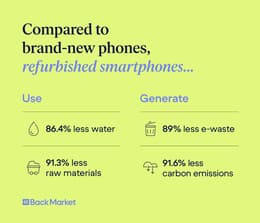
The future of cell phones
As we wrap up our journey through the history of cell phones, it’s only natural to ask what’s next. Tech manufacturers continue to launch new cell phones, constantly seeking new ways to up themselves and their competitors.
In this era of mass production, it’s important to consider the planet — and your budget — while staying on top of the latest tech trends. That's where refurbished tech becomes increasingly relevant.
In a time where waste is a huge environmental issue, refurbished phones substantially benefit the planet by keeping valuable devices out of overcrowded landfills.
So, if you’re in the market for a new phone, consider Certified B organizations that will help you find your perfect smartphone while doing some good.






